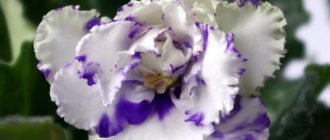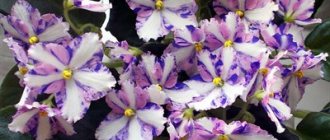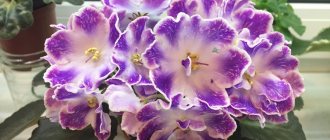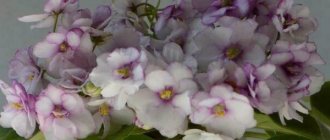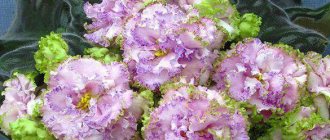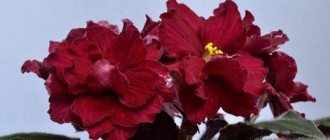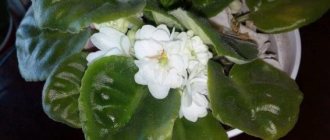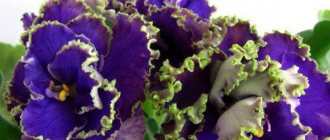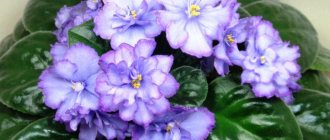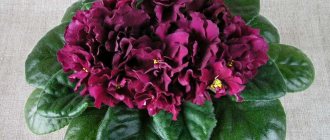Violet PIK-Byzantium (M. Pikalova)
Tomato Cornabel f1: description of the variety and cultivation characteristics
PIK-Byzantium belongs to the genus of hybrid Saintpaulias from the Gesneriev class. The variety was bred in 2010 by domestic breeder M. Pikalova, which is confirmed by the prefix “PIK” before the name.
The rosette is compact, but tends to lift up its leaves, forming a head of cabbage. The leaves are medium-sized, light green, round, quilted with a slight waviness along the edge. The cuttings are not very long, but thin and rather fragile.
The flowers are medium-sized and have an interesting wasp-like shape. The petals are narrow, have a dense texture and fringe.
The color is very interesting - marbled, consisting of shades of white, pink and crimson. Along the edge, the fringe differs in color unevenly, it is often interrupted and has a green or bronze color.
Attention! This exotic beauty has no known sports. But this does not mean that this cannot happen. It may also not be a sport, but simply an unusual flowering associated with the conditions of detention
It may also not be a sport, but simply an unusual flowering associated with the conditions of detention.
Violet Bohemia: description of the variety and characteristics
Violet goddess of beauty 19 photos description of Saintpaulia variety ek-goddess of beauty features of planting and care
Violet Bohemia: video
The wild form of Saintpaulia is native to East Africa and can be found in the forests of Tanzania and Rwanda. Violet Boheme is considered an evergreen, herbaceous, perennial plant with short stems. The foliage is hard, pubescent, and capable of forming rosettes. The shape and color of the foliage may vary. The flowers are large and collected in clusters. In the capsule fruits, a large number of small seeds ripen. Taking wild forms as a basis, it was possible to develop a number of varieties that have different shapes of flowers and inflorescences, differ in flowering time, different shapes, sizes and colors of foliage. Those varieties that were bred by breeders are often called hybrid Saintpaulias. Due to the fact that the varieties differ in color, shape of flowers and foliage, it has become possible to breed and then cross a large number of different varieties, so you can find a large number of plants that can be grown at home. Also, quite often, when growing violets, you can encounter sporting - manifestations of traits that are not characteristic of a particular variety. The form that was obtained in this way is called sport. For this reason, sport often becomes an impetus for work related to the development of a new variety. This phenomenon is not often found among varieties with a single color. Most often found among varieties that have complex selection, it is characterized by a combination of properties of a number of initial forms. The process of sporting is obtained through the inheritance of both dominant and recessive characteristics. The latter can happen quite rarely and acts as a surprise for gardeners. Russian breeders were able to develop a large number of varieties that are resistant. This is exactly the variety that Boheme is. Breeder Pikalova developed an original variety of the plant (PIK-Bohemia) with white-pink flowers, on which there are sparse lilac specks and a brown-green interrupted border on fringed foliage. The foliage of the PIK-Bohemia violet is dense, with virtually no fibers. The AB-Bohemia variety was bred by A.V. Tarasov became famous among flower growers in the second decade of the 21st century. Violet AB - Bohemia is distinguished by slightly pointed tips of the foliage and double, corrugated flowers, which are collected in dense inflorescences and form a cap during flowering. The petals have an unusual color - black and burgundy. There are varieties of AV-Bohemia sports, which differ from each other in the original color of the petals and the shape of the inflorescences. They can be found on sale under the name AV-Bohemia Sport.
Introduction
Violet Bohemia: photo
In many specialty gardening stores, you can find attractive plants that have dark green foliage, hairs, and beautiful flowers. They are often mistaken for violets, but in fact this plant is a Saintpaulia. Those who breed plants call it Uzambara violet. In fact, Saintpaulias do not belong to the violet family. Its discovery occurred purely by chance in the 90s of the 19th century. Saintpaulia was opened by the military commandant of the Uzambara district of the German colony in East Africa - Walter von Saintpaul. For this reason, the plant became the owner of its name - Saintpaulia. He sent seeds to Germany, which after some time showed the first shoots. Of course, anyone who has seen this plant will immediately note its similarity to violets, but this is only an external similarity. But many flower growers do not like to go into detail about what classification this or that plant belongs to, which is why this variety is called violets.
AV-Bohemia
Violet macho
violet AV-Bohemia from the Violetkeeper collection
Watch this video on YouTube
What does the AB violet variety look like, Your Grace, photo and description? Feeriya777 over a year ago tags: indoor plants, Saintpaulia, varieties of violets, Uzambara violet. Violet AV-Bohemia belongs to the Fialkovod selection.
Violet AV-Bohemia is not very easy to find; it always stands out from the blooming collection. Slightly pointed leaf tips are deep dark green. Dark red double flowers and abundant lush and early flowering. Beautiful flower shape.
Dark green, slightly wavy, pointed leaves. Violet AV-Bohemia (760-4). Flower: Double ruffled maroon pansy.
Rosette: Dark green, slightly wavy, pointed leaves. What does violet AB Lacy lilac look like, photo and description? Feeriya777 2 years ago tags: indoor plants, Saintpaulia, varieties of violets, violet, flowers.
From this article you will learn what conditions the PIK-Bohemia violet (M. Pikalova) imposes on its owner when grown at home, so that its flowering is full and long, and the rosette is healthy and. Violet "Bohemia": description and cultivation features. They are known to flower growers as Uzambara violet. On sale they are often called AV-Bohemia sport. Violet Bohemia, like any other, requires careful soil preparation before planting.
Unfortunately, even if a store-bought substrate states that it is suitable for Saintpaulia, this does not guarantee success. AB-Bohemia, like any violet, prefers light soil with sourness (can be determined using special indicator paper). It won't be difficult to create one. Violet AV-Bohemia sports.
Flower: Ghost. Terry wavy white stars with a crimson edge and a penciled black and red border. Rosette: Light green pointed leaves. After reading this article, you will learn what the chimera violet Olenka (EK and PT) looks like.
Description and photo, features of the chimeric violet variety Olenka, proper watering, fertilizing and lighting of the plant at home. Buy violet AV-Bohemia (Violetkovod). Order a violet. Terry corrugated dark burgundy pansies.
Dark green, slightly wavy, pointed leaves.
Description
The wild form of Saintpaulia is a native of East Africa and can be found in the forests of Tanzania and Rwanda. It is an evergreen herbaceous perennial plant with a short stem. Quite hard, pubescent leaves form a basal rosette. The shape and color of the leaves varies. Large flowers are collected in clusters. Many small seeds ripen in the capsule fruits.
Based on the wild form, a number of varieties have been bred, differing in the shape of flowers and inflorescences, flowering time, shape, size and color of leaves. Selected varieties are often called hybrid Saintpaulia. The process of their breeding began with the spread of the African flower in Europe.
Variation in the color and shape of flowers and leaves became the basis for the breeding and subsequent crossing of many varieties, which made it possible to obtain a huge variety of these indoor plants.
Often, when breeding violets, so-called sporting occurs, that is, the manifestation of unexpected characteristics not characteristic of the variety. The form obtained in this way is called: sport. Often it is sports that become the beginning of work on developing new varieties.
The least susceptible to this phenomenon are varieties with monochromatic flowers, and to a greater extent are varieties with complex selection that combine the properties of a number of initial forms. Sporting occurs due to the inheritance of both dominant and recessive traits. The latter can appear very rarely and become a surprise for the grower.
Russian breeders have developed a number of resistant varieties, not least of which are violets from the “Bohemia” varietal group. For example, the original variety PiK-Bohemia by breeder M. Pikalova is distinguished by white-pink flowers with sparse lilac specks and a brown-green interrupted border on fringed petals. Violet leaves are dense, practically devoid of villi.
The AB-Bohemia variety (bred by A.V. Tarasov) began to spread among flower growers in the middle of the second decade of the 21st century. The violet is distinguished by slightly pointed tips of the leaves and double, corrugated flowers, collected in dense inflorescences that form a cap when flowering. The color of the petals is unusual: they are black and burgundy. There are a number of AV-Bohemia sports, distinguished by the original color of the petals and the shape of the inflorescences. On sale they are often called AV-Bohemia sport.
Preparing violets for transplantation
- Water the plant 180 minutes before replanting so that it slips out of the container, but the soil does not stain the leaves.
- Clear the roots from the soil, cut off damaged and rotting ones (up to 80% of the roots can be removed painlessly for the plant).
- If rot is detected, treat with charcoal.
- If the roots are completely destroyed, the rosette is first rooted in water and then moved to the ground.
- Watering during the “move” is carried out with settled water, the temperature of which is several degrees higher than room temperature.
Violet “chic poppy”: features and care
While the violet is taking root, it must be covered to avoid rapid evaporation of moisture, but holes must be made for the passage of air. Watering is not carried out before rooting begins, so for the comfort of the plant, place a damp cloth around the pot or put moss in a tray.
How to care for a plant
The care cannot be called specific. It comes down to the traditional scheme for growing violets. Watering is carried out as the soil dries, trying to ensure that the stream of water does not fall on the plant and does not flow down to the base of the bush. Pour water carefully along the edges of the flowerpot, making sure to evenly soak the soil. For irrigation, use only clean and warm water, which is pre-settled.
It is allowed to use special fertilizers to increase the resistance of violets to diseases and insect pests that provoke them. It is recommended to buy such products only in a special garden center and strictly follow the instructions given on the bottle with the drug. The best effect, according to experts, is shown by fertilizers and additives in liquid form.
In summer, it is recommended to shade the “Nibelungen gold” violet, protecting it from hot rays. In winter - protect from cold and draft. Replanting is carried out no more than once a year, completely replacing the soil mixture from the pot. In this case, a new pot is taken with a larger volume, about 1 cm wider than the previous one. This helps stimulate flowering, rather than increasing green mass and developing the violet root system.
Well, almost black violet Dark Night of The Soul
Home flower with red flowers When talking about almost black varieties, it is impossible to ignore the Dark Night of The Soul variety.
A beautiful, even, symmetrical rosette, semi-miniature in size, which forms independently. The leaves are variegated, rounded, and quite large. A special feature of the variety are spoon-shaped leaves, the edges curl slightly upward. The color of the leaves is variegated, medium green with white.
The flowers are wine-black, double pansies with a coral-red underside. In bud, the half-opened flower is almost black, but as it opens it acquires a red, rather beet-like, hue.
Important! This variety is the only one bred by McDonald outside the Mac's series
violets from other domestic breeders
AB-Watermelon Snow (Violetgrower)
Description: Large double white flowers with pink bright prints on the petals. Dark green quilted leaves. New for 2016.
Available: sheet
Description: Large double wavy purple-violet stars. A neat rosette of dark green pointed leaves. The first flowering does not always reveal its potential. Abundant flowering, immediately increases the flower head.
Available: Leaf, Baby
AV-White Carnation (Violetflower)
Description: Densely double white ruffled stars with crimson petal edges. Wavy, medium green, pointed leaves. New for 2016.
Available: sheet
AV-Babushkina Violet (Violet grower)
Description: Semi-double frilled pansy with pink edge and pink eye. Raspberry fantasy in the center of the flower. A neat, medium green rosette with slightly wavy leaves.
Available: adult
AV-Strawberry (Violet grower)
Description: White pansies with a wavy edge. Pink eye and pink border. Along the edge of the eye are grains of crimson fantasy. Medium green foliage, compact rosette.
The most popular varieties of the AB series and their photos
Home orange flower name
Every collector has types that are the most popular. And the violet grower is no exception.
Polar bear
The flowers of this species are large and voluminous. They resemble balls in shape. The color of the petals is white, and the flowers themselves are densely double. The leaves are medium green, slightly wavy and quilted at the edges. Plant sizes are standard. It was withdrawn in 2022.
Bohemia
This indoor flower became available to Russian flower growers in 2015. The color of the flowers is similar to that of fragrant ripe cherries - it is burgundy-black. Dark green foxtails have sharp tips. This sorso blooms on all sides, the flowers form a dense ball resembling a hat.
We recommend watching a video about the violet variety “Bohemia”:
Kishmish
This variety of violet will allow you to grow large flowers, shaped like stars. The petals are dark crimson, their edges are white, corrugated. The rosette is compact and has medium green, toothed leaves that are slightly wavy. The variety was bred in 2015.
Coral Castle
The variety exhibits semi-double and double flowers. They look like pansies with a ruffled brown edge. Their color is coral-raspberry. The leaves are green, wavy and oval in shape. The bush sizes are standard.
Crimean Cherry
Pansies are distinguished by their corrugated petals. The flowers are double type and have a dark burgundy color. Leaves are dark green. They have an oval shape and a pointed tip. The leaves are slightly wavy. Standard sizes.
We recommend watching a video about the violet variety “Crimean Cherry”:
Terry Petunia
The flowers of this plant resemble roses with white petals, and along the edges there is a corrugated edging of dark cherry color. This is a small standard with a compact socket. It has medium green wavy leaves. The variety was released in 2022.
Mexican Jerboa
The branches are large, their color is ash-pink. They are shaped like stars. There is a dark crimson edging. The edges are wavy. The leaves are dark green, wavy. Compact size socket. The variety was released in 2022.
We recommend watching a video about the violet variety “Mexican Jerboa”:
Mimosa
Mimosa is a semi-double flower whose shape resembles stars. The flowers are semi-double, have a wide corrugated green edge and a crimson edging. The leaves are quilted, medium green. The variety is standard, was obtained in 2022.
Natasha Rostova
Flowers are double type, large in size. They have wavy edges. The shape of the flower resembles stars. The color of the petals is white, and they are framed by a crimson edging. The leaves are medium green and serrated. This variety was released in 2022
Plush
The stars are large, semi-double. Their color is purple-violet, and the edging is dark purple. The texture of the foliage is such that it visually and to the touch resembles plush. They are dark green in color, pointed at the edges and quilted. The variety is standard, released in 2022.
The Snow Queen
White stars of large size and semi-double type. They are distinguished by a corrugated purple edge and a fancy blue eye. The leaves are medium green, jagged and slightly wavy. The plant was bred in 2022.
Furor
It is distinguished by huge and semi-double stars. Their color is white and their edges are wavy. Fcussion prints are scattered across the petals. The leaves are quilted, toothed, and medium green in color.
Tango
The plant forms large double-type stars. The color of the petals is dark cherry. The rosette is medium green, flat. The leaves are green, wide, and have a slight velvety feel on the outer surface.
Gypsy Wedding
These are semi-double pansies, which are distinguished by a bright red spot located in the center of the flower. the edging is corrugated and green. The foliage is also wavy and dark green in color.
To ensure long-term flowering, it is important to regularly use complex mineral fertilizers
Mysterious forest
It is distinguished by huge and semi-double stars. Their color is white and their edges are wavy. Fcussion prints are scattered across the petals. The leaves are quilted, toothed, and medium green in color.
Bomb
This variety was released in 2022. Its flowers are huge and pink. They can be single or semi-double. They are shaped like bells. The edges of the petals are white. The rosette contains black and green quilted leaves. Plant sizes are standard.
Absolem
The variety was released in 2022. It is distinguished by large double white stars. They have wavy edges that are purple in color. The braid is wide and green. Present on the upper petals. Quilted medium green leaves form on the rosette.
We recommend watching a video about the Absolem violet variety:
Description
The wild form of Saintpaulia is a native of East Africa and can be found in the forests of Tanzania and Rwanda. It is an evergreen herbaceous perennial plant with a short stem. Quite hard, pubescent leaves form a basal rosette. The shape and color of the leaves varies. Large flowers are collected in clusters. Many small seeds ripen in the capsule fruits.
Based on the wild form, a number of varieties have been bred, differing in the shape of flowers and inflorescences, flowering time, shape, size and color of leaves. Selected varieties are often called hybrid Saintpaulia. The process of their breeding began with the spread of the African flower in Europe.
Often, when breeding violets, so-called sporting occurs, that is, the manifestation of unexpected characteristics not characteristic of the variety. The form obtained in this way is called: sport. Often it is sports that become the beginning of work on developing new varieties.
The least susceptible to this phenomenon are varieties with monochromatic flowers, and to a greater extent are varieties with complex selection that combine the properties of a number of initial forms. Sporting occurs due to the inheritance of both dominant and recessive traits. The latter can appear very rarely and become a surprise for the grower.
Russian breeders have developed a number of resistant varieties, not least of which are violets from the “Bohemia” varietal group. For example, the original variety PiK-Bohemia by breeder M. Pikalova is distinguished by white-pink flowers with sparse lilac specks and a brown-green interrupted border on fringed petals. Violet leaves are dense, practically devoid of villi.
The AB-Bohemia variety (bred by A.V. Tarasov) began to spread among flower growers in the middle of the second decade of the 21st century. The violet is distinguished by slightly pointed tips of the leaves and double, corrugated flowers, collected in dense inflorescences that form a cap when flowering. The color of the petals is unusual: they are black and burgundy. There are a number of AV-Bohemia sports, distinguished by the original color of the petals and the shape of the inflorescences. On sale they are often called AV-Bohemia sport.
Violet "Bohemia" - description and cultivation features
We all know that violets are an integral part of the comfort of every home. They soothe with their delicate colors. There are actually a lot of varieties of violets, and there are also a lot of people who breed violets. And one of the most famous is the breeder Fialkovod.
Short description:
Violet AV-Bohemia (Violetkovod selection):
Size: Standard Leaf: dark green, pointed at the edges, slightly wavy Flowers: burgundy-wine, double
Cap-shaped flowering of AV-Bohemia
Bohemia is sold as a leaf, as a child and as an adult plant. Prices range from 200 rubles for one leaf and up to 1200 rubles for an adult flower.
When the variety first appeared on the market, prices for planting material started from one and a half thousand rubles.
Also bought with this variety:
Rebel's Restless Heart
RS-Snow in April
AB-Gypsy Wedding (744-21)
AB-Javan Moss (736-30)
AV-Ray of Light (746-80)
Bohemia is ready for landing
Before you bring home a leaf or baby of Violet AB-Bohemia, you need to prepare a high-quality substrate. Those who breed violets at home know that if the package says “for Saintpaulias or violets,” this is not a guarantee of successful planting.
Reminder! Setting the stage
- Mix one part of coarse river sand with three parts of peat and five parts of black soil.
- For the top layer, sphagnum moss, vermiculite and brick chips are suitable. Remember, the total mass of additives must be less than one of the main parts - river sand.
- Another popular composition for planting violets is a mixture where half of the sand is mixed, one part of coniferous soil, leaf soil, moss and two parts of turf.
- Pieces of clay pots or ordinary expanded clay will serve as drainage.
- Don’t forget to steam the soil and disinfect it with manganese. At the time of planting, the soil should remain loose and moist.
Preparing the substrate for planting
Where to plant
In order for a plant to feel comfortable, it needs favorable conditions. In the case of Bohemia it is:
- A darkened window or excluding direct sunlight: violet loves diffused light.
- The comfortable room temperature for violets is the same as for humans: not lower than 18, but not higher than 24 degrees Celsius.
- Permissible air humidity is 50 percent.
- Use soft water for irrigation, only a couple of degrees warmer than room temperature. Carefully monitor the moisture content of the substrate, as excessive moisture will destroy the plant.
- We fertilize the violet carefully even when the formation of buds begins. It is advisable to reduce the dose indicated on fertilizer packages by five times.
Polar bear
The flowers of this species are large and voluminous. They resemble balls in shape. The color of the petals is white, and the flowers themselves are densely double. The leaves are medium green, slightly wavy and quilted at the edges. Plant sizes are standard. It was released in 2015.
Bohemia
This indoor flower became available to Russian flower growers in 2015. The color of the flowers is similar to that of fragrant ripe cherries - it is burgundy-black. Dark green foxtails have sharp tips. This sorso blooms on all sides, the flowers form a dense ball resembling a hat.
We recommend watching a video about the violet variety “Bohemia”:
Kishmish
This variety of violet will allow you to grow large flowers, shaped like stars. The petals are dark crimson, their edges are white, corrugated. The rosette is compact and has medium green, toothed leaves that are slightly wavy. The variety was released in 2020.
Coral Castle
The variety exhibits semi-double and double flowers. They look like pansies with a ruffled brown edge. Their color is coral-raspberry. The leaves are green, wavy and oval in shape. The bush sizes are standard.
Crimean Cherry
Pansies are distinguished by their corrugated petals. The flowers are double type and have a dark burgundy color. Leaves are dark green. They have an oval shape and a pointed tip. The leaves are slightly wavy. Standard sizes.
Distinctive features for the varieties being developed
The main feature of the varieties under consideration is uniqueness. All flowers have corrugated edges.
The plants are unpretentious in terms of care. Care includes watering, fertilizing, creating a favorable humidity climate .
Important : Watering should be done as the soil dries, using settled water. Grow at air humidity of 50% and temperature 20-22 degrees. AB violets are propagated by cuttings.
Dangerous diseases include:
- gray rot;
- powdery mildew;
- leaf spotting.
The violets of the Violet breeder are incredibly beautiful and interesting flowers . They have a variety of colors and flower shapes. They are not fussy to care for, so even an inexperienced gardener can choose them for breeding, observing basic agrotechnical rules.
No less remarkable are the varieties of violets bred by breeders Evgeny Arkhipov, Elena Korshunova, Boris and Tatyana Makuni, Natalya Puminova, Konstantin Morev, Tatyana Pugacheva, Natalya Skornyakova, Elena Lebetskaya, Svetlana Repkina and Tatyana Dadoyan, which you can learn about from separate materials on our website.
Violet PIK-Bohemia (M. Pikalova)
Bohemia, translated from the French boheme, means nothing more than gypsy.
Its interpretation is an eccentric lifestyle. It is typical for a certain part of the artistic intelligentsia. And also for those who have a similar lifestyle: theatrical and artistic circles and their environment.
Genus, family
- The Bohemia variety belongs to the Gesneriaceae family;
- Type: Saintpaulia. Sauntpoulia ionanta;
- Saintpaulia violetflower or Saintpaulia violetflower.
Origin story
Fringed green-white-pink flowers with intermittent green-brown ruffles and sparse lilac specks against a background of a bright green rosette. This is how the author presents his creation. Pikalova Marina Vladimirovna.
She was interested in flowers even in her youth:
- Roses;
- Hydrangeas;
- Clematis;
- Lilies;
- And before that there were palm trees, ferns, orchids.
It was not possible to grow violets. When Nance Leigh was seen at the exhibition, her new story began. With Saintpaulias.
She began to develop new varieties at a more mature age. It works better with semi-miniatures.
These are its most famous varieties:
Hawaiian rose;
Aurora;
Vanechka;
Poplar fluff.
Photo and description of the variety
Double star-shaped white flowers with numerous pink-lilac shades and splashes. The greenish border on the petals is not continuous. She breaks off. But on some petals it is absent;
- A neat semi-miniature rosette of bright green curved leaves with jagged edges. Short petioles allow the leaves not to open the middle of the rosette;
- Peduncles are short and strong. They confidently hold all the flowers above the rosette. No blockages.
Let's sum it up
The AB-Bohemia variety is one of the favorites of violet growers, because it has a compact rosette , beautiful erect peduncles and produces gorgeous, cap-like blooms. The only complaint that is found on thematic forums is aimed at the high cost of planting material.
That is why many prefer to wait for the variety to become more widespread, since AV-Bohemia is not yet available in all stores, but is already found at exhibitions and on social networks, where owners not only sell, but also exchange flowers.
When is an AV-Bohemia transplant needed?
Seasoned flower growers say that replanting for AV-Bohemia is not an emergency measure, but a mandatory annual procedure, which it is advisable to leave for spring or autumn.
At other times of the year, it is better not to start replanting, as the flower may not adapt to the new pot.
Important! The new transplant goes into a larger pot. If you do not plan to change the container, then you will have to partially cut off the roots of the violet - no more than 80%. If the flower has not had time to grow, then it is permissible to leave the old pot, however, be sure to clean and disinfect it
For a young plant, replanting takes place while preserving a small clod of soil, replacing the drainage and the rest of the soil. Compaction is carried out after two to three waterings
If the flower has not had time to grow, then it is permissible to leave the old pot, however, be sure to clean and disinfect it. For a young plant, replanting takes place while preserving a small clod of soil, replacing the drainage and the rest of the soil. Compaction is carried out after two to three waterings.
Reminder! A transplant is urgently needed if:
- the top layer is covered with a whitish coating
- fertilizing does not help revive fading leaves
- found many densely spaced roots
- the quarantine of the new flower is over
- young growth of a rosette emerges from a rooted leaf
If the plant is young, then it is permissible to transship it by increasing the size of the pot and adding fresh soil.
Increasing the size of the pot for violet AB
How to make Boheme bloom
Abundant flowering of an experienced violet will help give rejuvenation. If the trunk of a flower is bare, it’s time to help it. Following the steps for correct transplantation, we remove part of the roots and leaves, and, if necessary, the entire underground part (it is important to use a disinfected knife).
If the roots are preserved, then change the pot to a smaller one. If only the trunk is left, place it in a glass of water until new roots appear.
Blooming AV-Bohemia
Drought-resistant steppe plants with flowers
This chapter lists steppe flowers with names that do not tolerate stagnant moisture.
Adonis (ADONIS). Ranunculaceae family.
Adonis vernalis (A. vernalis) is an elegant spring plant of the steppes of Europe and Siberia. It is a perennial with a short rhizome and branched stems, forming a bush 20-30 cm high. The leaves are light green, thinly divided.
The flowers are single, bright yellow, up to 8 cm in diameter, shiny and very elegant. Adonis blooms in early spring (late April - early May).
Growing conditions. Sunny areas with rich, loose, alkaline soils, well drained. This drought-resistant steppe plant with flowers does not tolerate stagnant water.
Reproduction. Preferably by seeds, as it does not tolerate dividing the bush well. The seeds do not germinate quickly throughout the year. Sow freshly harvested. Planting density - 5-6 bushes per 1 m2.
Adonis is a difficult plant to cultivate and is a subject for experienced hobbyists. But if planted correctly, it can decorate a flower garden for 10-15 years without replanting.
Anaphalis. Family Asteraceae (Asteraceae).
Two species of this drought-resistant steppe plant growing in East Asia and North America are cultivated. A bush with erect stems 50-80 cm high, with white-tomentose pubescence on stems, leaves and flowers. The leaves are narrow, linear, entire. At the ends of the shoots there are small silvery baskets in a corymbose inflorescence. Easily self-seeding.
Types and varieties:
Anaphalis three-veined (A. triplinervis) - with larger leaves.
Pearl anafalis (A. margaritacea) - leaves are smaller.
Growing conditions. Sunny areas with dry neutral soils.
Reproduction. By dividing the bush (spring, late summer), by seeds (sowing before winter). Transplantation and division after 3-4 years. Planting density -9 pcs. per 1 m2.
Used in mixed flower beds, mixborders, and rockeries.
Goniolimon (GONIOLIMON). Lead family.
Steppe and semi-desert perennials, typical “tumbleweeds”, forming a dense spherical bush 10-40 cm high from highly branched inflorescences and oblong ovate leaves collected in a ground rosette.
Look at the photo: these steppe flowers, which are silvery “balls,” can decorate any flower garden on dry soil and a winter bouquet.
Types and varieties:
Beautiful goniolimon (G. speciosum) - rosette leaves are round, bluish, the inflorescence is in the shape of an “antler”.
Tatarian goniolimon (G. tataricum) - leaves are ovoid, pointed, the inflorescence is looser, corymbose.
Growing conditions. Sunny areas with deep, well-drained soils with added sand. They do not tolerate stagnant moisture. Salinity resistant.
Reproduction. Preferably by seeds, seedlings bloom in the 2-3rd year, it is better to replant young plants. Cuttings are possible in the spring. Planting density is single.
An excellent plant for rockeries or as tapeworms on dry slopes, against the background of an inert layer (crushed stone or gravel). They are also used in arrangements, especially in winter bouquets.
Choosing a pot
No matter how you feel about plastic, it is the best material for violets when it comes to flower pots. The fact is that the evaporation of water in such containers does not occur so quickly, therefore, the frequency of watering is reduced and the life of the plant increases.
Plastic pot for violets
Clay pots can destroy the plant. An SOS signal for the gardener will be fading leaves or traces reminiscent of the visit of small insects. The reason is the contact of clay and leaves. It is not necessary to replant the flower, save it, and at the same time decorate it, you can use raffia, sisal or coconut fiber.
As for the size, we select the diameter of the pot to be three to three and a half times smaller than the violet. You should not immediately take a large pot, the flower will not be able to master the huge earthen lump.
Young rosettes are initially placed in pots no larger than 5 centimeters in diameter, increasing in size after about six months.
Attention! The violet will not bloom until it fills everything with roots, so there is no need to rush here.
Reviews from flower growers about the plant
Reviews of Nibelungen gold violets emphasize the ease of growing this Saintpaulia variety and confirm the true beauty of the plants. Flower growers say that with minimal care it is possible to grow a beautiful flower in a pot that will delight you with flowering for a long time. The selection varieties are unique, and the opportunity to purchase this type of violet has become a real gift for flower lovers. Having the opportunity to grow an exclusive plant on your window, and also try to breed it and see how the babies turn out, is the best opportunity for flower lovers to diversify their favorite hobby.
What does a Humaco Inches violet look like?
Humako Inches violet is the most common among indoor plant lovers. This is due to its extraordinary beauty: the combination of snow-white edges of the petals with a blue-violet core stands out brightly against the background of light green leaves. The rosette of leaves looks neat and compact, framing multiple flower stalks.
Amazing color of the Humaco Inches variety
Due to the small fibers located on all the leaves of the plant, as well as the velvety surface of the petals, the violet is covered with many sparkling reflections of the sun. This effect makes the flower even more decorative.
For your information! Violet variety Humaco belongs to the Gesneriev family. This is a hybrid variety developed by the Dutch floriculture company Humako. The company name appears in the name of each of their plants. But the word “inches” is translated as “inches,” which is an indication of the size of the varietal violet.
In nature, plants of this family can reach a height of 30 cm, but indoor varieties are much smaller in size.
About the history of appearance
The violet was first found in the mountains of East Africa, so the variety is often called Uzambara after the name of the mountains.
The scientific name of the violet genus is Saintpaulia. The word comes from the German language, derived from the name of Baron Saint-Paul, who first found the most beautiful flower. His breeder friend immediately bred the first domestic Saintpaulia, which in just a few decades won the love of flower growers all over the planet and became the ancestor of modern varieties of violets.
The color gradient may vary between specimens
Note! Violets were not named that way because of their purple color. The name of the flower comes from the word “viola” - that’s what it’s called in Latin.
In Polish, this word was modified to “fialek”, from there it passed into Russian as “violet” and became the basis for the name of the color.
“Deciphering” the words in the names of violets
Found a mistake? Report it: 1) Select the error with the mouse 2) Press CTRL+Enter. Read more.
It can be difficult for beginning violet lovers to figure out what the prefixes in the names of violets mean. Who knows interesting and useful facts about what the various words and prefixes in the names of varieties mean? Share your information with newcomers.
Often we don’t think about which breeder created this or that variety, but perhaps you will stop for a moment and think that in your hands you have not just a violet, but a VARIETY. And behind this variety stands the person who created it, his soul, his mood, his emotions, his imagination and colossal work. It’s not so easy to give a variety a name, a NAME, but by giving the variety a name, the breeder gives this variety to you. So treat the violet with soul and understanding!
For example: prefix Rob`s
Ralph Robinson breeds miniature and semi-miniature Saintpaulias. Recently, he has become increasingly interested in Saintpaulias with crown variegation, i.e. those in which the young leaves are the most interestingly colored. The names of the Saintpaulias of his selection begin with Rob's.
Ma`s
example: Ma's Winter Moon
Olive Ma Robinson is a breeder of standard Saintpaulias. Its varieties with the prefix Ma's are becoming increasingly popular. __________________________________________________________
Lyon's
example: Lyon`s Magic Sharm
One of the most “titled” breeders, Paul Sorano, is the owner of the world-famous plant, which is over 50 years old. There is probably no collector who does not have Sorano varieties! Saintpaulias of the Sorano selection are repeated winners and prize-winners of insertions. Sorano varieties are mostly without the prefix, but some have the Lyon's prefix.
EK - Elena Vasilievna Korshunova (Tolyatti)
example: EK-Hymn of Youth
AN - Natalya Filippovna Andreeva (Moscow region) SL - Vyacheslav Aleksandrovich Konopatchenkov (Moscow)
Ukrainian selection: LE - Elena Anatolyevna Lebetskaya (Vinnitsa)
example: LE-Fuchsia lace
_____________________________________________________ LiK - Lazarenko Galina Vladimirovna (Zaporozhye)
example: LiK-Star Veil
_____________________________________________________ RS - Repkina Svetlana Nikolaevna (Lugansk)
example: RS-Foam Priboy
Growing rules
In nature, Saintpaulias grow in tropical rainforests. The soil there is quite light, rich in humus, but by no means waterlogged. Violet grows most often in elevated, and therefore relatively dry, areas. Purchasing special ready-made soil will not always be a reliable guarantee that your violet will like it. However, flower growers have long developed a recipe for preparing a soil mixture that is completely suitable for African violet.
- It is necessary to prepare the ingredients, it is better to do this in the summer. You will need fine river sand, peat and garden soil rich in humus (ideally black soil).
- The steamed ingredients must be thoroughly mixed in a ratio of 1X3X5.
- It is advisable to fill the bottom part of the pot with expanded clay.
- The top layer can be sprinkled with brick chips.
- Planting is carried out in moderately moist crumbly soil.
It is better to place the pot with violet so that direct sunlight does not fall on it. In its homeland in East Africa, it grows under the canopy of a multi-layered tropical forest, sunlight reaching its leaves many times dispersed by the tree crowns. In terms of air temperature, the violet is an excellent pet; it is quite comfortable at the same temperature as a person (from 18 to 22°).
A healthy plant needs to be watered 1-2 times a week, preferably in the morning. Under no circumstances should the soil be over-moistened: excessive moisture is detrimental to this plant. The rotting process can be very difficult to stop. Often it is excessive watering that causes the death of violets. She is also very picky about fertilizers. They must be applied at the beginning of flowering, reducing the dose indicated in the instructions by half.
Plastic pots are great for violets: they retain moisture better, which allows you to water the plant less often. The size of the pot is also a very important factor in determining the health of Saintpaulia. Often its flowering is delayed because there is too much soil in the pot. The violet blooms when its roots fill the entire volume of the pot.
However, replanting is necessary and even necessary, so it is better to do it in the off-season: in spring or autumn. If you replant it in the same pot, you will have to reduce the number of roots. To preserve the root system, you need to choose a slightly larger pot and be prepared for the fact that the violet will not bloom for some time. The drainage of the pot must also be replaced: unwanted microorganisms may begin to develop in the old one. Repotting into a smaller pot can encourage flowering.
Modern varieties of violets are most often propagated using leaves. Saintpaulia has a wonderful feature: it can form young plants at the leaf cut.
In the next video you can take a closer look at the “Bohemia” violet variety.
Unanswered messages | Active topics
List of forums » Violet House » Exhibitions in the Violet House
Current time: Thu Apr 04, 2022 16:33
List of forums » Violet House » Exhibitions in the Violet House
Current time: Thu Apr 04, 2022 16:33
Reproduction methods
Violet Gold of the Nibelungs: photo of the variety
Receiving shoots from the violet variety Gold of the Nibelungs should be done in the same way as for other subspecies of Saintpaulia. To propagate and grow this plant, you only need one leaf, and it will be best if this leaf is from the central part of the rosette, and it is of middle age (not old and not quite young). Another main factor is that the plant from which the leaf was taken is flowering and completely healthy. Violet Gold of the Nibelungs after the flowering period, or exhausted, will not be able to produce good offspring. The cut of the selected leaf should be treated using a manganese solution or coal powder, and then put it in a container with water. This is done so that the leaf can take root. Given that the leaf is quite viable, after 2.5 weeks it will be able to produce roots, then it can be transplanted into the soil. Not often, but Saintpaulias can still be diluted with part of the leaf. A part of the leaf is taken, about 40 millimeters, after which it is planted in moist soil. A stand is placed under this leaf so that the leaf rises above the ground. After which the leaf should be provided with a temperature of approximately 31 degrees, sufficient lighting and moderate watering, so that the leaf takes root well. It is worth noting that this method of reproduction cannot give a 100% successful outcome. There is another method of propagating the violet Le Gold of the Nibelungs - this is by seed. Before obtaining seeds, pollination of flowering crops should be done; to do this, carefully remove the stamen from the testis and pour its contents onto previously prepared paper, after which we begin to plant the pollen on the stigma of the pistil. If within a week and a half there was an increase in the size of the ovary, then the pollination process was quite successful. The seeds then ripen over a period of 6 to 9 months. Thanks to this, it is possible to get a new plant, and even a new subspecies. But it is worth noting that this method can only be performed by a fairly experienced gardener, and it does not always work out the first time.
